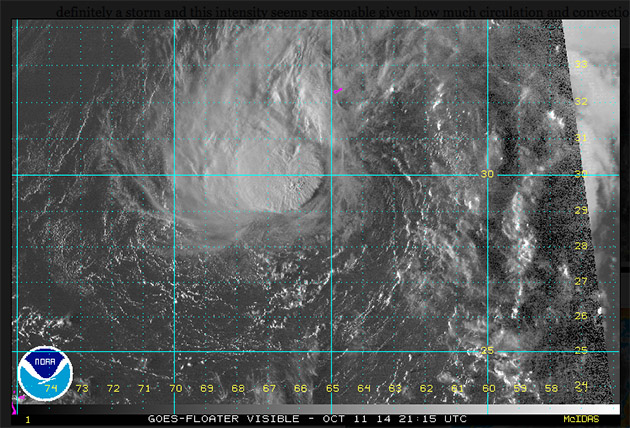Posted in:
“Andrea” is Hurricane Season’s First Named Storm

Subtropical Storm Andrea formed last week and was named by the National Hurricane Center in Miami, Florida, the agency responsible for monitoring all tropical disturbances in the Atlantic. This marks the first named storm of 2019, even before the official start of the Atlantic hurricane season, which begins June 1 and runs through November 30. Dr. Mark Guishard, program manager of the Risk Prediction Initiative at BIOS, explained how the storms form and their potential impacts.
What are subtropical storms?
A subtropical storm is a weather disturbance that relies on warm water as its “fuel,” similar to a hurricane, but also gains some of its energy from cold features in the upper part of the atmosphere. This means it’s a hybrid system that‘s not quite a full tropical storm, and not quite a winter-type system (like a winter gale). It spins up by using energy from aspects of the environment that we have in the region of the north Atlantic that we call the subtropics, which borders both the warm tropics to the south and the cooler mid-latitudes to the north.
Can they be dangerous?
Subtropical storms have sustained winds that are as strong as a gale or tropical storm, in the range of 34-63 knots (39-72 mph). If a subtropical storm attains winds of hurricane strength (64 knots, or 74 mph), then it is usually gaining strength as a tropical system and will be upgraded to a hurricane. The confluence of these features can often occur in early (or even pre-) hurricane season, when there are still cold fronts and other cold upper-level features moving through the area. However, later in the season—September through November—when there is warmer water near the surface of the ocean, subtropical storms are most prevalent, can intensify more quickly, and can even turn into hurricanes.
Because of Bermuda’s geographical location, we have historically had subtropical storms that spin up near the island with little warning. In October 2001 a subtropical storm (which later became Hurricane Karen) formed near the island, causing widespread power outages and knocking down a large amount of vegetation. While the Bermuda Weather Service issued a winter-type storm warning, there was criticism that it wasn’t enough to give sufficient warning to the population. In 2002, as a result of Bermuda’s experience, NHC started naming subtropical systems. Thankfully, this allows local forecasters to issue a wider array of tropical storm and hurricane warnings associated with these systems, if the forecast warrants.

What advice do you have?
Keep monitoring the National Hurricane Center and the Bermuda Weather Service through hurricane season, which runs June 1 through November 30, a full 6 months of the year. Have a hurricane plan in place for the occurrence of hurricanes, tropical and subtropical storms. At the time of this writing, Bermuda Weather Service is only forecasting Small Craft Warning conditions for Bermuda associated with Subtropical Storm Andrea. If there’s a silver lining to this cloud, it’s that people’s awareness of subtropical storms will be increased, hopefully inspiring more preparedness for this year’s hurricane season.
Tagged: